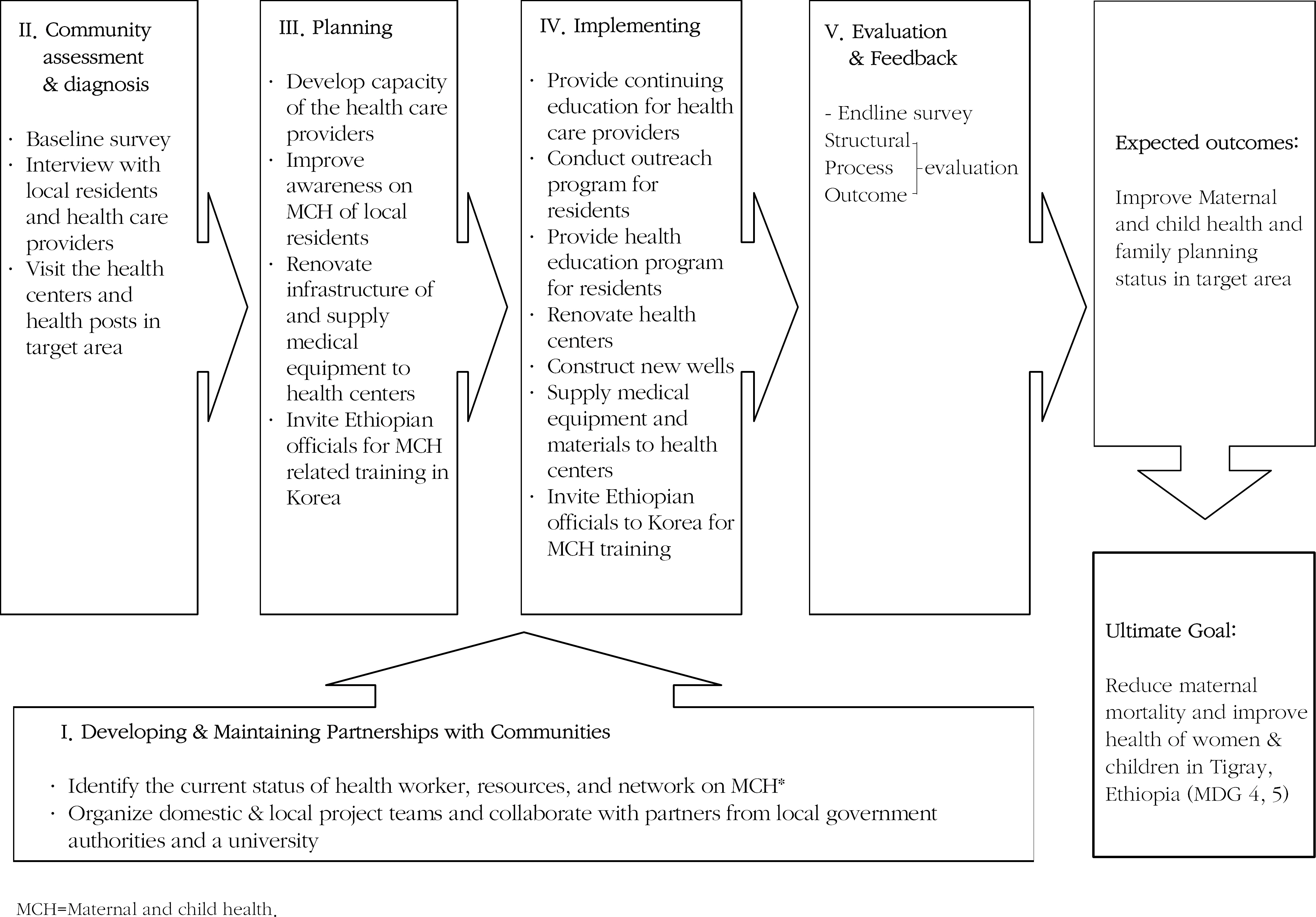Perspect Nurs Sci.
2014 Apr;11(1):1-9.
Global Health Project for Maternal Child Health in a Developing Country: Case Study in Tigray, Ethiopia
- Affiliations
-
- 1Professor, College of Nursing, The Research Institute of Nursing Science, Seoul National University, Seoul, Korea. ksbang@snu.ac.kr
- 2Professor Emerita, College of Nursing, The Research Institute of Nursing Science, Seoul National University, Seoul, Korea.
- 3Associate Professor, College of Nursing, The Research Institute of Nursing Science, Seoul National University, Seoul, Korea.
- 4Graduate student, College of Nursing, Seoul National University, Seoul, Korea.
Abstract
- PURPOSE
The purpose of this study was to demonstrate a two-year global health project to improve maternal and child health (MCH) in Ethiopia.
METHODS
This is a descriptive case study. The target area is Kilte Awlaelo Woreda in Tigray Regional State, Ethiopia. A baseline survey was conducted to identify the needs of community residents and health care professionals. A MCH program was developed according to a project design matrix that included: infrastructure renovation of health centers; continuing education for midwives, nurses, and health extension workers (HEWs); and improvement of residents' MCH awareness. Project evaluation will examine the structure, process, and outcomes of the program.
RESULTS
The baseline survey showed low rates of family planning (31%) and antenatal and postnatal care use (36.1% and 69%, respectively). The institutional birth rate was 13.5%. Midwives and nurses received 2~4 educational programs about family planning and perinatal care. HEWs were also given practical education. Water and electrical infrastructure of all five health centers in the Kilte Awlaelo Woreda were renovated. Additionally, medical supplies and equipment were provided. Community health education on perinatal care, family planning, and personal hygiene was presented.
CONCLUSION
This study highlights the role of nursing in global health and provides basic information on the development and outcomes of the global health project.
Keyword
MeSH Terms
Figure
Reference
-
References
1. WHO.int [Internet]. Geneva: Global Health Observatory-Maternal mortality;; [cited 2013 Nov 21]. Available from:. http://www.who.int/gho/maternal_health/mortality/maternal_mortality_text/en/index.html.2. WHO.int [Internet]. Geneva: Global Health Observatory-Under-five mortality;; [cited 2013 Nov 21]. Available from:. http://www.who.int/gho/child_health/mortality/mortality_under_five_text/en/index.html.3. Likis FE. Midwives are essential to global maternal and child health. J Midwifery Womens Health. 2011; 56(5):425–6. http://dx.doi.org/10.1111/j.1542–2011.2011.00114.x.
Article4. Hogan MC, ForemanKJ , Naghavi M, Ahn SY, Wang M, Makela SM, et al. Maternal mortality for 181 countries, 1980–2008: a systematic analysis of progress towards Millennium Development Goal 5. Lancet. 2010; 375(9726):1609–23. http://dx.doi.org/10.1016/S0140-6736(10)60518–1.
Article5. Moyer CA, Adanu RM, Engmann CM. The relationship betweenfacility-based deliveryandmaternalandneonatalmortality in Sub-Saharan Africa. Int J Gynaecol Obstet. 2013; 122(3):263–5. http://dx.doi.org/10.1016/j.ijgo.2013.04.010.6. Horton R. Maternal mortality: surprise, hope, and urgent action. Lancet. 2010; 375(9726):1581–2. http://dx.doi.org/10.1016/S0140–6736(10)60547–8.
Article7. Fullerton JT, Johnson PG, Thompson JB, Vivio D. Quality considerations in midwifery pre-service education: exemplars from Africa. Midwifery. 2011; 27(3):308–15. http://dx.doi.org/10.1016/j.midw.2010.10.011.
Article8. Nkowane AM, Boualam L, Haithami S, El Sayed el TA, Mutambo H. The role of nurses and midwives in polio eradication and measles control activities: a survey in Sudan and Zambia. Hum Resour Health. 2009; 7:78. http://dx.doi.org/10.1186/1478-4491–7–78.
Article9. Kruk ME, Pacz kowski MM, Tegegn A, Tessema F, Hadley C, AsefaM , et al. Women ‘spreferences for obstetric carein rural Ethiopia: a population-based discrete choice experiment in a region with low rates of facility delivery. J Epidemiol Community Health. 2010; 64(11):984–8. http://dx.doi.org/10.1136/jech.2009.087973.10. Reutter L, Kushner KE. 'Health equity through action on the social determinants of health': taking upthe challenge in nursing. Nurs Inq. 2010; 17(3):269–80. http://dx.doi.org/10.1111/j.1440–1800.2010.00500.x.11. Pitt C, Greco G, Powell-Jackson T, Mills A. Countdown to 2015: assessment of official development assistance to maternal, newborn, and child health, 2003–08. The Lancet. 376 (. 9751. ): 1485–96.http://dx.doi.org/10.1016/S0140-6736(10)61302-5.12. KOICA.go.kr [Internet]. Kyunggi-do: KOICA; [updated 2013 Jun 4; cited 2013 Sep 27]. Available from:. http://www.koica.go.kr.13. Dayilypharm.com [Internet]. Seoul: Dayily pharm;c1999. -2012 [updated 2013 Apr 2; cited 2013 Sep 27]. Available from:. http://www.dailypharm.com/News/169187.14. Lee H, LeeT, Shin H, Ahn H, Kim M, Lee M.Patterns andpre-dictors of non-use of family planning methods in Ethiopian women: a panel survey. Int Nurs Rev. 2013; 60(3):335–43. http://dx.doi.org/10.1111/inr.12028.15. Forsetlund L, Bjorndal A, Rashidian A, Jamtvedt G, O'Brien MA, Wolf F, et al. Continuing education meetings and workshops: effects on professional practice and health care outcomes. Cochrane Database Syst Rev. 2009(2):): CD003030.http://dx.doi.org/10.1002/14651858.CD003030.pub2.
Article16. Kitaw Y, Ye-Ebiyo Y, Said A, Desta H, Teklehaimanot A. Assessment of the training of thefirstintake of Health Extension Workers. Ethiop J Health Dev. 2007; 21(3):232–9.
Article17. Shin H, Kim E, Yoo B, Lee H. Development of a community-based participatory global health project model for primary health care capacity development: a case study from a rural communit yin Ecuador. JKorean Acad Community Health Nurs. 2010; 21(1):31–42. http://dx.doi.org/10.12799/jkachn.2010.21.1.31.18. Ruger JP. The changing role of the World Bank in global health. Am J Public Health. 2005; 95(1):60–70. http://dx.doi.org/10.2105/ajph.2004.042002.
Article
- Full Text Links
- Actions
-
Cited
- CITED
-
- Close
- Share
- Similar articles
-
- Effects of Maternal-Child Health Education Program for Nurses in Tigray, Ethiopia on Their Knowledge and Confidence
- Effects of a Community Outreach Program for Maternal Health and Family Planning in Tigray, Ethiopia
- Community diagnosis of health life style in the maternal community: A project for maternal & child health at Ban Nong Loob division in Thailand
- Burden of Neck Pain and Associated Factors Among Sewing Machine Operators of Garment Factories in Mekelle City, Northern Part of Ethiopia, 2018, A Cross-Sectional Study
- Maternal Health in the COVID-19 Era: Unraveling Complexities and Long-term Implications for the Journal of Korean Maternal and Child Health


